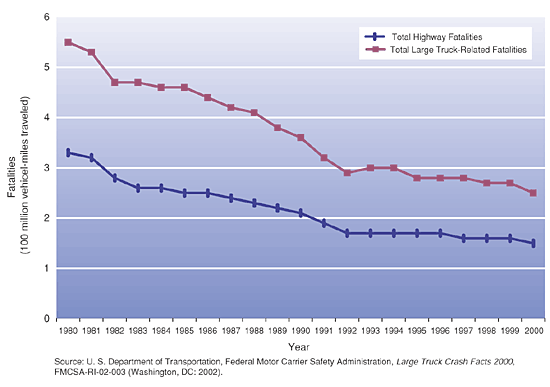Key Freight Transportation Challenges
Safety
Safety is a top priority of the U.S. Department of Transportation and a major goal in every public and private sector transportation program. Many safety initiatives undertaken by the department and in cooperation with the private sector have resulted in improvements in transportation's safety record. Still, there is room for improvement. In 2000, more than 41,800 people were killed and over 3 million people were injured on our Nation's highways. About 12 percent of all highway fatalities involved large trucks (USDOT FMCSA 2002).
Figure 11. Large-Truck Fatality Rates: 1980 - 2000

View the data for figure 11 [HTML, Excel 20KB]
In recent years, increasing volumes
of freight moved on all modes have heightened concerns about safety. One
concern relates to the mix of freight and passenger vehicles competing
for use of the transportation system. Today’s fast-paced global economy
requires just-in-time operations, bringing a greater number of vehicles
into close proximity, especially, along highways, but also in the air and
on rail lines. Current trends indicate that passenger travel and freight
movements will grow substantially in the foreseeable future. Although actions
to separate passenger and freight services have been suggested, such as
truck-only lanes and dedicated high-speed passenger rail lines, it is likely
that most passenger travel and freight movements will continue along shared
rights-of-way in the foreseeable future.
Likewise, growth in recreational boating and cargo traffic, particularly barges,
plying shared waters presents safety risks to both boaters and mariners. About
one-third of the 734 recreational boating fatalities in 1999 involved collisions
with other vessels. The U.S. Coast Guard expects the number of recreational
boaters to increase by 65 percent to 130 million annually by 2025. Approximately
75 percent of all domestic trade (800 million short tons) is moved on barges
that are either towed or pushed by tugs through coastal and inland waters where
recreational boaters are found (USDOT BTS 2001b).
Another safety concern relates
to the growing number of new carriers in the freight industry. Transportation
deregulation in the past two decades has removed entrance barriers, commodity
restrictions, and preapproved route assignments, prompting a major increase
in the number of carriers, especially in the highway mode. Similarly, rail
deregulation has allowed large Class I railroads to downsize their systems,
spinning off low-volume lines, which have often been converted to new short
line and regional railroads with lower operating costs.
Because of increased competition among carriers, the number of new businesses
has grown dramatically and many of them move into and out of the marketplace
more frequently. For example, in 1990, there were 216,000 interstate motor
carriers operating in the United States. In 1999, the number increased to more
than 517,000 (USDOT BTS 2001c). Increased competition among a larger pool of
carriers has brought lower transportation costs to consumers, but it has also
meant that many carriers have marginal profit margins. Where competition is
fierce, and profits are slim or nonexistent, concerns intensify that spending
on safety will be the first line item reduced.
Thus, a major challenge for the department and private industry is to reduce fatalities and injuries in the face of increasing freight and passenger traffic. The Federal Motor Carrier Administration (FMCSA), for example, has set a goal of reducing truck-related fatalities by 50 percent by 2010. Other modes are also committed to reducing fatalities and injuries in transportation.
previous | next